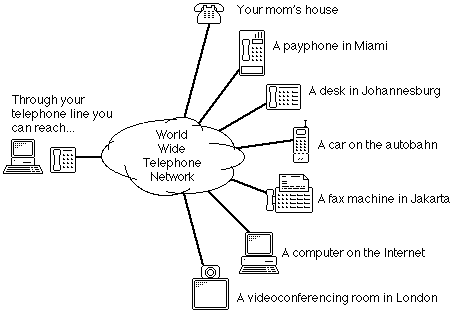CT Everywhere! | ||
Computer | The "C" in "CT" stands for "computer" in its broadest sense. Think of it as any device using "computer technology". While this set of devices certainly includes traditional mainframes and minicomputers, as well as your own personal computer, it also includes many others. For example, personal digital assistants (PDAs) are small, handheld devices that generally have much less power than traditional computers and a more limited set of uses. But as personalized information appliances, PDAs are very important when it comes to telephony integration. Similarly, a whole new generation of intelligent, programmable consumer electronics products will transform everyday devices such as VCRs, TVs, watches, games, etc., into what we consider to be "computers" for purposes of CT. | |||||
 | ||||||
Telephony | The telephone network is the largest and single most important network in the world. Virtually any human being on the planet is able to interact with any other through the telephone network and it acts as the interconnection between, most other networks in the world. In fact, there are very few people, fax machines, computers or data networks in the world that cannot be reached through the worldwide telephone network. Despite the high levels of acceptance for various other forms of information technology, including consumer electronics products and personal computers, the telephone (in all of its forms) remains the only communication device that can be considered ubiquitous. | ||||
 | |||||
Computer Telephony | CT provides an alternative means of accessing the power of telephony technology. Computers are empowering because they allow people to extend their reach, and they can take on time-consuming and non-creative tasks. Computer technology allows for tremendous customization and personalization. You can have a user interface and work environment that is optimized for your needs. CT gives you full access to the power of the telephony technology you need in the form that is best for you. A computer working on your behalf becomes your assistant. Using CT technology, your computer can screen calls, handle routine requests for information without your intervention, and interact with callers in your absence. The following examples illustrate how computer technology amplifies the power of telephony and makes it more accessible.
| |||
The Promise of CT Technology | The motivation behind CT is customization and control. The real significance of integrating computer technology with telephony is the opportunity to tie any form of intelligent appliance, whether it be a mainframe computer, personal computer, or other personal information appliance, into the telephone system in order to create a customized, and preferably personalized, communications environment. The ultimate promise of information technology is that it empowers people to collaborate with one another more effectively and with greater ease. Since the invention of the telephone over a century ago (in 1876), telephony technology has evolved tremendously. Innovation was fast and furious in the earliest days after Alexander Graham Bell's invention; it took less than two years to commercialize the technology. To this day the pace has not slowed. While modern computer technology is a much more recent invention, its history has been just as fast-paced. The key is their ability to improve the ways people communicate and collaborate, because these activities are at the heart of all human endeavor. | |||
© Copyright 1996-2004 For more information, contact Michael Bayer at Computer Telephony Solutions | |